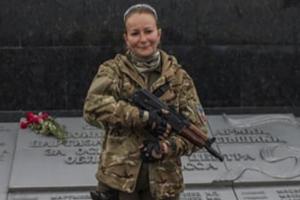Research
Women Warriors: SIS Prof. Co-Authors Book on Female Combatants

If you scroll through global news sites like BBC or Al Jazeera, you’re accustomed to seeing young men gearing up for combat. But there’s also a surprising number of women fighting in conflict zones, and it’s an oft-overlooked aspect of modern warfare. In fact, in certain regions, the presence of female soldiering is not even all that new.
Jessica Trisko Darden delves into this subject in a new book, Insurgent Women: Female Combatants in Civil Wars. Familiar concerns about armed men “killing women and children” civilians are powerful, but they don’t always apply. It’s often women who are fighting and dying for a nation or a cause.
“Since the early 2000s, there has been a strong focus at the UN, and in the policy world, on women as peacemakers. That only tells one side of the story, and I think it’s important to tell both sides. Women can contribute to conflict as much—or perhaps more—than they can contribute to peace,” says Trisko Darden in an interview. “We’re challenging all of the stereotypes that we have about who participates in combat.”
At American University, Trisko Darden is an assistant professor in the School of International Service. She’s active in Washington policy discussions and is now an inaugural Jeane Kirkpatrick Fellow at the American Enterprise Institute.
Trisko Darden co-authored Insurgent Women—due out in February—with Alexis Henshaw of Troy University and Ora Szekely of Clark University.
A Prominent Role
The book is broken into three parts, based on three case studies of women fighting in civil wars. Trisko Darden focuses on female fighters in Ukraine, while Henshaw examines Colombia, and Szekely writes about Kurdish militant groups and the broader Middle East.
Ukraine has a long tradition of women participating in insurgency. Dating back to the 1920s and 1930s, women were involved in independence campaigns against Poland, Nazi Germany, and eventually the Soviet Union. Trisko Darden studied contemporary participants on both sides of the civil war. There are women fighters with the Ukrainian armed forces, the oligarch-funded militias aligned with the military, and the Russian-backed, pro-separatist groups in the Donbass.
To aid her research, Trisko Darden was able to utilize social media. “I watched hours and hours of YouTube videos with female combatants. A lot of that could be dismissed as propaganda. But I think even if we take it at face value as propaganda, the messaging—and the prominent role that women play in the messaging—tells us a lot about the conflict.”
She says female fighters in armed groups affiliated with the Ukrainian military tend to be younger, and grew up in post-Soviet Ukraine. Women in pro-Russian rebel groups—with stronger connections to Russia and its language—tend to be older, have children, and own property.
“We wanted to draw attention to the complex pathways that women follow into combat,” she says. “We’re highlighting not so much the different roles that women play vis a vis men, but the different roles that women play amongst themselves—across different organizations and across different conflicts.”
Female Identity, Women’s Empowerment
Still, there are noticeable differences between male and female combat experiences. In the book, one rebel commander memorably compliments a female fighter and former kindergarten secretary.
“She goes into the field to rescue our fighters when they are wounded,” he said, “plus she is our best sniper…she can cook for us, she can drive our tank.”
A woman’s gender identity doesn’t have to be hidden, and it’s sometimes even accentuated. For instance, pro-Russian rebels organized a beauty pageant for their female fighters.
“There is tension over gender roles and women’s involvement in combat,” Trisko Darden explains. “And there’s been less of a need for women to shed their femininity in the way that I think there has been for women in the US military.”
Rebel fighting can also be part of women’s empowerment and liberation. And they’re facing risk factors not shared by their male counterparts. Some female Kurdish fighters sign up to elude forced marriages, and many Colombian women joined the FARC guerrilla movement to escape domestic violence. Women were present in the Kurdistan Workers’ Party (PKK) at its founding, and with more female commanders, this enabled the recruitment of more women soldiers.
“They also have a tendency to establish women’s rights platforms, and these kinds of women’s rights platforms have expanded into LGBTQ platforms as well. So it’s become part of a broader project of social emancipation in what are rather conservative cultures,” she says.
Why They Fight
So, why are women fighting in these civil wars? It’s often noble values of patriotism, with a desire to protect their families and better their communities. But Trisko Darden says there isn’t one easy explanation.
“Some women are motivated by a sense of adventure, and danger, and independence,” she says. “But there’s also a sense of defending their nation. The same reasons that many people join militaries.”
Research has shown women traveling long distances to fight in military battles. Yet in areas suffering from internal strife, it’s sometimes about stepping forward when no one else will.
“Particularly in Ukraine, there’s this sense that men aren’t doing enough, and that’s really strongly articulated. They’ll say, ‘If the men were here to defend us, then we wouldn’t have to do this. But the men aren’t doing their jobs.’”